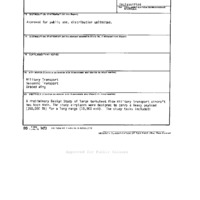-
Title
-
Wing Planform Geometry Effects on Large Subsonic Military Transport Airplanes
-
Date
-
1978
-
Index Abstract
-
Coming Soon
-
Photo Quality
-
Not Needed
-
Report Number
-
AFFDL TR 78-16
-
Creator
-
Kulfan, Robert M.
-
Vachal, John D.
-
Corporate Author
-
Boeing Commercial Airplane Company
-
Laboratory
-
Air Force Flight Dynamics Laboratory
-
Date Issued
-
1978-02
-
Extent
-
71
-
Identifier
-
ADA056124
-
Access Rights
-
Approved for public release; distribution unlimited
-
Distribution Classification
-
1
-
Contract
-
F33615-76-C-3035
-
DoD Project
-
2404
-
DoD Task
-
240410
-
DTIC Record Exists
-
No
-
Distribution Change Authority Correspondence
-
None
-
Abstract
-
A Preliminary Design Study of large turbulent flow military transport aircraft has been made. The study airplanes were designed to carry a heavy payload (350,000 lb) for a long range (10,000 nmi). The study tasks included: Wing geometry/cruise speed optimization of a large cantilever wing military transport airplane; Preliminary design and performance evaluation of a strut-braced wing transport airplane; and Structural analyses of large-span cantilever and strut-braced wings of graphite/epoxy sandwich construction (1985 technology). The best cantilever wing planform for minimum takeoff gross weight, and minimum fuel requirements, as determined using statistical weight evaluations, has a high aspect ratio, low sweep, low thickness/chord ratio, and a cruise Mach number of 0.76. A near optimum wing planform with greater speed capability (M = 0.78) has an aspect ratio = 12, quarter chord sweep = 20 deg, and thickness/chord ratio of 0.14/0.08 (inboard/outboard).
-
Report Availability
-
Full text available
-
Provenance
-
AFRL/VACA
-
Type
-
report
-
Format
-
1 online resource
 AFFDLTR78-016.pdf
AFFDLTR78-016.pdf